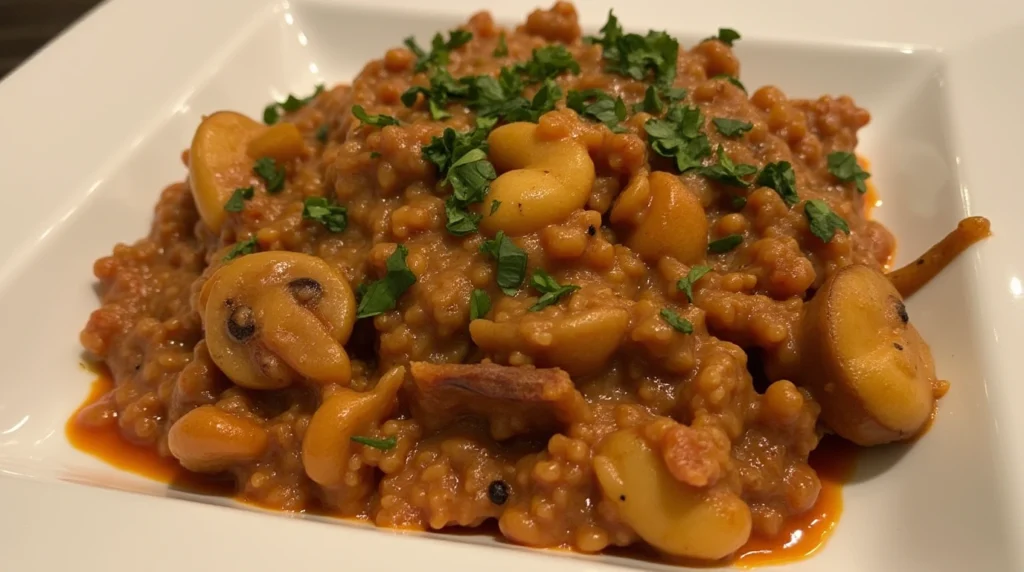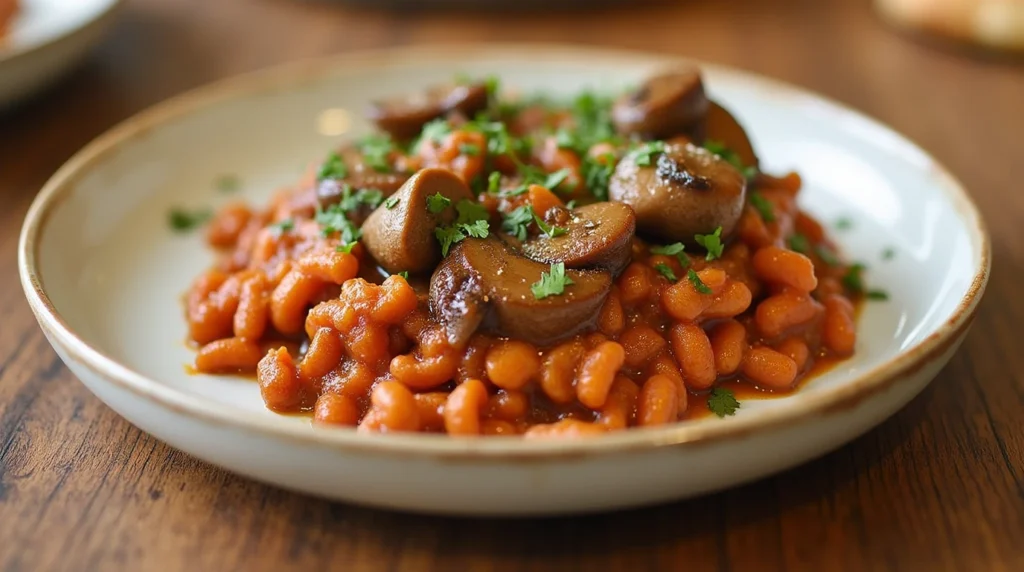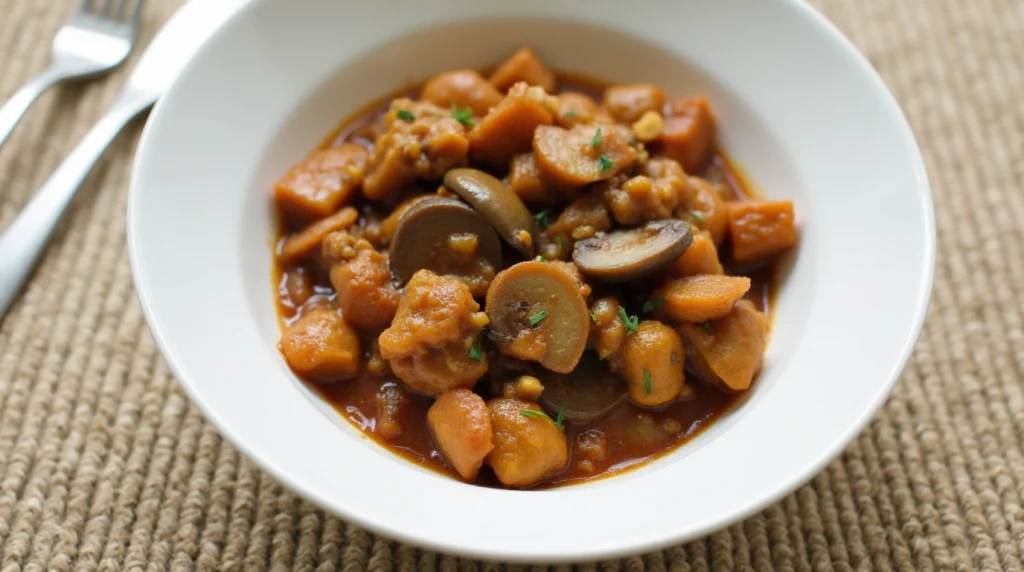Introduction

There’s something magical about creating a dish that brings warmth and comfort to your table. Imagine this: a deep, earthy sauce simmering on the stove, filling your kitchen with aromatic scents that make you crave every bite. That’s what mushroom ragu is all about—a savory, plant-based alternative to traditional meat sauces that’s packed with umami-rich flavors. Whether you’re a vegetarian, vegan, or simply looking to add more variety to your meals, mushroom ragu is here to transform your pasta nights into culinary masterpieces. Let me take you through how you can craft this rich and flavorful recipe right at home.
Understanding Mushroom Ragu – What Makes It Special
Defining Mushroom Ragu and Its Origins
Mushroom ragu originated in Italian cuisine as a hearty, slow-cooked sauce traditionally made with mushrooms instead of meat. This vegetarian version offers a robust, satisfying taste profile without compromising depth. Here’s why it stands out:
- Vegetarian Appeal : Perfect for those seeking plant-based options while still enjoying the richness of classic ragus.
- Cultural Roots : Rooted in Tuscan traditions, mushroom ragu uses locally sourced ingredients like wild porcini and San Marzano tomatoes.
Types of Mushrooms Commonly Used
Not all mushrooms are created equal when it comes to making ragu. Some varieties bring unique textures and flavors that elevate the dish:
- Porcini Mushrooms : Known for their intense earthiness, these dried mushrooms add layers of complexity once rehydrated.
- Cremini Mushrooms : A great balance between flavor and texture, they’re perfect for beginners.
- Shiitake Mushrooms : Adds smokiness and depth, ideal for adventurous cooks.
- Button Mushrooms : Affordable and versatile, they work well blended with other varieties.
Why Mushroom Ragu Stands Out from Other Pasta Sauces
What sets mushroom ragu apart is its ability to deliver an umami-packed experience. The slow-cooking process allows flavors to meld together, resulting in a sauce that’s richer than many store-bought alternatives.
- Umami Flavors : Achieved through caramelization of mushrooms and reduction of liquids like red wine.
- Versatility : Works beautifully with various types of pasta, from fettuccine to rigatoni.
Health Benefits of Choosing Mushroom-Based Sauces
Switching to mushroom-based sauces isn’t just about taste—it’s also about nutrition.
- Low Fat Content : Unlike cream-heavy sauces, mushroom ragu relies on natural fats found in olive oil and cheese (optional).
- Rich in Nutrients : Mushrooms provide vitamins B and D, along with antioxidants.
Key Ingredients for a Perfect Mushroom Ragu
Mushrooms – The Star Ingredient
Choosing the right mushrooms is crucial for achieving the best results. Consider combining fresh and dried varieties for added depth.
- Fresh vs Dried : Fresh mushrooms offer juiciness, while dried ones contribute concentrated flavor. Rehydrate dried mushrooms in warm water before use.
Tomato Base – Essential for Balance
Tomatoes act as the backbone of any good ragu. Opt for high-quality canned San Marzano tomatoes or tomato paste for superior taste.
- San Marzano Tomatoes : Sweeter and less acidic compared to regular tomatoes.
- Tomato Paste : Concentrates the flavor, enhancing the overall richness.
Aromatics – Building Blocks of Flavor
Aromatic ingredients like garlic, onions, and herbs form the foundation of your sauce.
- Garlic and Onions : Sauté them gently to avoid burning, ensuring maximum flavor release.
- Herbs : Thyme, rosemary, and parsley complement the earthiness of mushrooms perfectly.
Optional Additions – Taking It to the Next Level
Experiment with optional ingredients to customize your ragu.
- Red Wine : Deglazes the pan and adds complexity. Use a dry red wine for best results.
- Vegetable Broth : Provides moisture and enhances the umami notes.
Step-by-Step Guide to Making Mushroom Ragu
Here’s a detailed guide to help you create the ultimate mushroom ragu:
Preparing Your Ingredients
Before starting, ensure everything is prepped correctly.
- Clean and slice your mushrooms thoroughly. Remove dirt gently using a damp cloth.
- Dice onions finely and mince garlic cloves for even distribution.
- Rehydrate dried mushrooms according to package instructions.
| Ingredients | Quantity |
|---|---|
| Fresh mushrooms (mixed) | 500g |
| Dried porcini mushrooms | 10g |
| Olive oil | 3 tbsp |
| Garlic | 2 cloves |
| Onion | 1 medium |
| Red wine | 1 cup |
| Tomato paste | 2 tbsp |
| Vegetable broth | 1 cup |
| Salt and pepper | To taste |
Building the Flavor Foundation
Start by cooking the aromatics to build a solid base.
- Heat olive oil in a large skillet over medium heat.
- Add diced onions and sauté until translucent.
- Toss in minced garlic and cook for another minute.
- Introduce sliced mushrooms, stirring occasionally until golden brown.
Cooking Down the Sauce
Once the foundation is ready, let the sauce develop its full potential.
- Pour in red wine and scrape up any browned bits from the bottom of the pan.
- Stir in tomato paste and vegetable broth, mixing well.
- Simmer uncovered for 30-40 minutes, allowing flavors to intensify.
Finishing Touches
Complete your ragu with final adjustments.
- Season generously with salt and pepper.
- Optionally, stir in a splash of heavy cream or grated Parmesan for creaminess.
- Taste and adjust seasoning if needed.

Serving Suggestions and Pairings
Best Pasta Types for Mushroom Ragu
Choose pastas that complement the thickness and texture of your sauce.
- Fettuccine : Absorbs the sauce beautifully.
- Pappardelle : Wide ribbons hold onto every drop of ragu.
- Rigatoni : Tubular shape traps the sauce inside.
Garnishes to Elevate the Dish
Simple yet impactful garnishes enhance presentation and flavor.
- Fresh Parsley : Adds freshness and color.
- Toasted Breadcrumbs : Offers crunch and texture contrast.
- Shaved Parmesan : Provides salty richness.
Side Dishes That Complement Mushroom Ragu
Pair your ragu with sides that balance the meal.
- Garlic Bread : Classic accompaniment that soaks up leftover sauce.
- Roasted Vegetables : Carrots, zucchini, or broccoli add variety.
- Green Salad : Lightens the meal with crisp greens.
Tips for Leftovers
Preserve your hard work for future enjoyment.
- Store cooled ragu in an airtight container in the refrigerator for up to 5 days.
- Freeze portions for up to 3 months; thaw overnight in the fridge before reheating.
Advanced Techniques for Elevating Your Mushroom Ragu
If you’re ready to take your mushroom ragu game to the next level, here are some advanced techniques and tips that will make your sauce stand out:
Using Umami Boosters
Umami is often referred to as the “fifth taste” and is essential for creating rich, savory flavors in dishes like mushroom ragu. Here’s how you can enhance umami:
- Nutritional Yeast : This deactivated yeast has a cheesy, nutty flavor and is packed with glutamates, which boost umami. Sprinkle a tablespoon into your sauce during the last few minutes of cooking.
- Soy Sauce or Tamari : A splash of soy sauce or tamari adds saltiness and depth without overpowering the dish. Use sparingly—about a teaspoon at a time.
- Miso Paste : White or yellow miso paste can be stirred into the sauce near the end of cooking for a subtle umami kick.
Incorporating Fresh Herbs Late in Cooking
Fresh herbs should be added toward the end of cooking to preserve their delicate flavors. Try these combinations:
- Parsley and Thyme : Classic Italian pairing that balances earthy mushrooms with brightness.
- Basil and Oregano : Adds a Mediterranean twist, perfect for summer evenings.
- Chives : Light and oniony, chives complement creamy versions of mushroom ragu.
Experimenting with Textures
Texture plays a crucial role in the dining experience. To keep things interesting:
- Crushed Red Pepper Flakes : For a hint of heat, sprinkle red pepper flakes over the finished dish.
- Walnuts or Pine Nuts : Toasted nuts add crunch and nuttiness when sprinkled on top.
- Truffle Oil : A drizzle of truffle oil elevates the dish with its luxurious aroma and flavor.
Nutritional Insights – Why Mushroom Ragu is Good for You
In addition to being delicious, mushroom ragu offers several health benefits. Understanding these aspects can motivate you to include this dish in your regular meal rotation.
Mushrooms – Nature’s Superfood
Mushrooms are low in calories but high in nutrients. They provide:
- Vitamin D : Especially if exposed to sunlight, mushrooms are one of the few plant-based sources of vitamin D.
- Antioxidants : Compounds like ergothioneine protect cells from damage.
- Fiber : Promotes digestive health and keeps you feeling full longer.
Tomatoes – Packed with Lycopene
Tomatoes used in ragu are rich in lycopene, a powerful antioxidant linked to heart health and reduced cancer risk. Cooking tomatoes increases lycopene bioavailability, making them even healthier.
Olive Oil – Heart-Healthy Fats
Extra virgin olive oil provides monounsaturated fats that support cardiovascular health. It also enhances the absorption of fat-soluble vitamins in the dish.
Common Mistakes to Avoid When Making Mushroom Ragu
Even experienced cooks can stumble when preparing complex sauces. Avoid these pitfalls to ensure success:
Overcrowding the Pan
Cooking too many mushrooms at once releases excess moisture, preventing proper browning. Instead, cook them in batches to achieve a golden crust.
Skipping the Deglazing Step
Deglazing the pan with wine or broth after sautéing mushrooms captures all those flavorful browned bits. Don’t skip this step—it’s where much of the sauce’s depth comes from.
Underseasoning
Mushroom ragu requires liberal seasoning due to its hearty nature. Taste frequently and adjust salt, pepper, and other spices as needed.

Variations of Mushroom Ragu – Exploring New Horizons
Once you’ve mastered the basic recipe, try these variations to keep things exciting:
Creamy Mushroom Ragu
For a decadent twist, incorporate heavy cream or coconut milk into the sauce. Reduce the liquid slightly before adding dairy to prevent curdling.
Vegan Mushroom Ragu
Make your ragu entirely plant-based by substituting vegetable broth for chicken stock and omitting Parmesan cheese. Replace cream with cashew cream or silken tofu for creaminess.
Spicy Mushroom Ragu
Add heat with chili flakes, harissa paste, or jalapeños. Balance the spiciness with a touch of honey or maple syrup for sweetness.
Storing and Reheating Mushroom Ragu
Proper storage ensures your hard work lasts beyond the first serving. Follow these guidelines:
Refrigeration
Cool the ragu completely before transferring it to an airtight container. Store in the refrigerator for up to 5 days.
Freezing Instructions
Portion the ragu into freezer-safe bags or containers. Label with the date and freeze for up to 3 months. Thaw overnight in the fridge before reheating.
Reheating Tips
Reheat gently on the stovetop, stirring occasionally. Add a splash of water or broth if the sauce thickens too much during storage.
Incorporating Seasonal Ingredients
Seasonality plays a significant role in cooking, and incorporating fresh, seasonal produce into your mushroom ragu can enhance its flavor and nutritional value.
Fall-Inspired Additions
During autumn, consider adding these ingredients to your ragu:
- Butternut Squash Purée : Adds natural sweetness and thickness to the sauce.
- Pumpkin Seeds : Toasted pumpkin seeds provide crunch and nuttiness when sprinkled on top.
- Chestnuts : Chopped chestnuts lend a festive touch to the dish.
Winter Warmers
In colder months, fortify your ragu with hearty additions:
- Kale or Swiss Chard : Stir chopped greens into the sauce for added nutrition.
- Carrots and Celery : Sweat diced carrots and celery along with onions for extra depth.
- Beef Stock (Optional) : While vegetarian-friendly, using beef stock instead of vegetable broth gives the sauce a richer, deeper flavor.
Spring Freshness
As spring arrives, incorporate lighter, fresher elements:
- Peas : Frozen peas add sweetness and texture when stirred into the finished sauce.
- Asparagus Tips : Sautéed asparagus tips bring a vibrant crunch to the dish.
- Fresh Mint : A pinch of mint adds brightness and unexpected complexity.
Hosting Tips – Making Mushroom Ragu for Guests
Entertaining friends and family? Mushroom ragu is an excellent choice for gatherings. Here’s how to make it shine:
Scaling Up the Recipe
To feed a crowd, simply double or triple the recipe. Use a large pot and adjust cooking times accordingly. Prepping ingredients ahead of time ensures smooth execution.
Presentation Matters
Presentation elevates any dish. Try these ideas:
- Individual Portions : Serve ragu in small bowls atop pasta for a restaurant-style presentation.
- Garnish Creatively : Use edible flowers, microgreens, or finely grated Parmesan shavings for visual appeal.
- Buffet Style : Set up a pasta bar where guests can choose their preferred noodles and toppings.
Allergen-Friendly Options
Ensure everyone feels included by offering allergen-free variations:
- Gluten-Free Pasta : Substitute traditional pasta with gluten-free alternatives like brown rice or quinoa pasta.
- Nut-Free Garnishes : Avoid nuts if serving guests with allergies; replace them with toasted breadcrumbs or seeds.
Troubleshooting Common Issues
Even experienced cooks encounter challenges. Here’s how to troubleshoot common problems when making mushroom ragu:
Sauce Too Watery
Excess liquid can dilute the flavor. To fix:
- Simmer uncovered for longer to reduce the sauce.
- Mix cornstarch with water and stir into the sauce for quick thickening.
Mushrooms Not Browning
Mushrooms release moisture when cooked, preventing browning. To achieve caramelization:
- Cook mushrooms in batches to avoid overcrowding the pan.
- Pat them dry before cooking to remove surface moisture.
Flavor Lacking Depth
If your ragu tastes flat, try these fixes:
- Add a splash of vinegar or lemon juice for acidity.
- Incorporate a piece of Parmesan rind during simmering for extra umami.
- Increase the amount of dried herbs or spices used.
Teaching Kids to Love Mushroom Ragu
Encouraging children to enjoy healthy, flavorful meals starts with involving them in the process. Here’s how to get kids excited about mushroom ragu:
Simplify the Recipe
Use fewer ingredients and milder flavors to appeal to young palates. Start with button mushrooms and omit strong seasonings like chili flakes.
Make It Fun
Let kids participate in preparation:
- Have them wash and tear mushrooms into pieces.
- Allow them to sprinkle cheese or garnishes onto individual servings.
Offer Choices
Provide kid-friendly pasta shapes and let them pick their favorite. Pair the dish with colorful sides like steamed broccoli or roasted sweet potatoes.

FAQs About Mushroom Ragu
Can I Freeze Leftover Mushroom Ragu?
Absolutely! Freezing preserves the quality of your sauce for later use. Proper storage ensures minimal loss of flavor.
Is Mushroom Ragu Gluten-Free?
Yes, the sauce itself is naturally gluten-free unless cross-contaminated during preparation. Ensure you choose gluten-free pasta if serving with noodles.
Do I Need Special Equipment to Make Mushroom Ragu?
Not at all! A sturdy skillet or pot and basic kitchen tools suffice.
How Long Does Mushroom Ragu Take to Cook?
Plan for approximately 30-45 minutes of simmering time to achieve optimal flavor development.
Conclusion
Making mushroom ragu at home is simpler than you might think, and the reward is a deeply satisfying dish that rivals restaurant-quality meals. By following this guide, you’ll unlock the secrets to crafting a rich, flavorful sauce that’s sure to impress family and friends alike. Don’t hesitate to experiment with different mushroom combinations and garnishes—your cr
